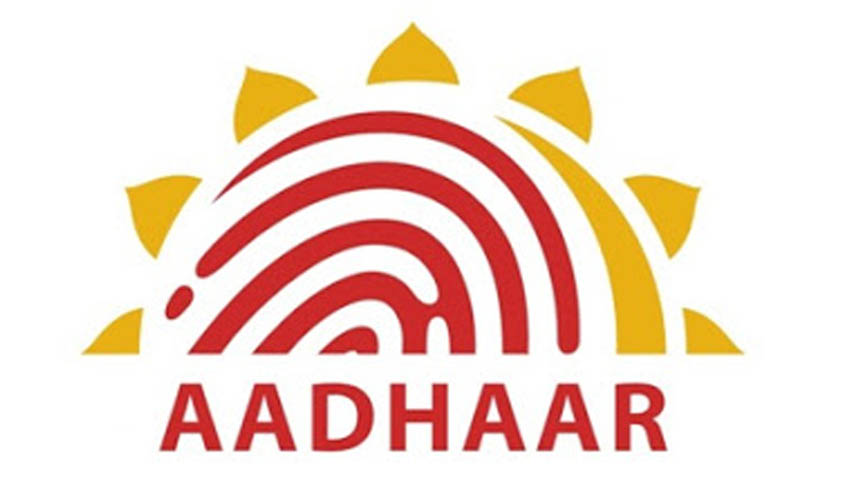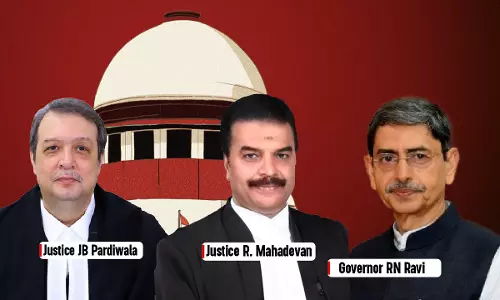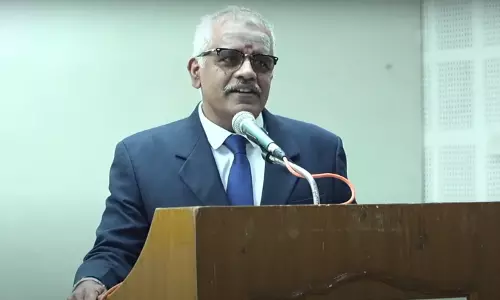
Ever wondered as to why bankers are immensely interested in biometric identification and verification of citizens? Biometric identification implies that movements of present and future generations of citizens are tracked like those of bacteria under a microscope. This exercise of creating a centralized ‘online database’ of biometric information of Indians is unfolding under the gaze of...
Ever wondered as to why bankers are immensely interested in biometric identification and verification of citizens? Biometric identification implies that movements of present and future generations of citizens are tracked like those of bacteria under a microscope. This exercise of creating a centralized ‘online database’ of biometric information of Indians is unfolding under the gaze of all the public institutions in general and the Supreme Court in particular. The core issue here is will efforts to undermine the fundamental right of Indians to move and transact freely around the country and to live without constantly having to prove who they are succeed or fail.
What is ironical is that while it is inevitable that no centralized electronic database of biometric information can be made leakproof in the post-Wikileaks and Edward Snowden world, the bankers, biometric technology companies and their collaborators are marketing it as an answer to increasing demand for identity proof and identity protection from citizens.
In 1998, National Biometric Test Center, San Jose State University, set up by the Biometric Consortium, which is the U.S. government interest group on biometric authentication was asked to testify to the USA’s House Committee on Banking and Financial Services hearing on “Biometrics and the Future of Money”. This testimony of May 20, 1998, was reprinted under the title, “Biometric Identification and the Financial Services Industry”. This centre emerged from a meeting of Biometric Consortium held in 1995 at the FBI training facility. This test centre has defined biometric authentication as “the automatic identification or identity verification of an individual based on physiological and behavioral characteristics”.
Whatever is happening in India is an exercise in imitation of what was attempted in the USA through the REAL ID Act of 2005 amidst bitter opposition. As of 2018, half of all the 50 states have taken extensions. One state, American Samoa has chosen not to comply with the REAL ID Act. It has been 13 years since the REAL ID Act was passed. The current round of extensions expires October 10, 2018, but the extensions are renewable.
The US Senate never discussed or voted on the REAL ID Act specifically and no Senate committee hearings were conducted on the Real ID Act prior to its passage exposing its undemocratic character and the bill's proponents avoided a substantive debate on a far-reaching piece of legislation by attaching it to a "must-pass" bill. Barack Obama had categorically opposed it during the 2008 presidential election campaign.
A significant number of US states are not participating in the program. Among other concerns they have argued is that it infringes upon states’ rights. Bills have been introduced into US Congress to amend or repeal it. The controversial $4-billion Real ID initiative is meant to provide secure licenses in the hands of 245 million Americans. It is surprising as to why unlike in the US, states in India are yet to argue on how the Aadhaar Act for Centralized Identities Data Repository (CIDR) of Unique Identification (UID)/Aadhaar numbers infringes upon states’ rights.
In India, when one looks at the definition of the “Biometrics” which “means the technologies that measure and analyse human body characteristics, such as ‘fingerprints’, ‘eye retinas and irises’, ‘voice patterns’, “facial patterns’, ‘hand measurements’ and ‘DNA’ for authentication purposes” as per Information Technology (Reasonable Security Practices And Procedures And Sensitive Personal Data Or Information) Rules, 2011 under Section 87 read with Section 43A of the Information Technology Act, 2000, it becomes clear that the plan of data collection does not end with collection of fingerprints and iris scan it goes quite beyond it. As per Section 2 (g) of the Aadhaar (Targeted Delivery of Financial and Other Subsidies, Benefits and Services) Act, 2016, “‘biometric information’ means photograph, fingerprint, iris scan, or such other biological attributes of an individual as may be specified by regulations”.
The fact remains biometric data like fingerprint, voice print, iris scan and DNA do not reveal citizenship or residentship. While the use of biometric technology, an advanced technique for the identification of humans, based on their characteristics or traits is unfolding, there is an agency within India too. These traits can be face, fingerprint, iris, voice, signature, palm, vein and DNA. DNA recognition and vein recognition are the latest and most advanced types of biometric authentication. Biometric technology is being deployed in the application areas like government, travel and immigration, banking and finance, and defense. Government applications cover voting, personal ID, license, building access, etc.; whereas travel and immigration use biometric authentication for border access control, immigration, detection of explosives at the airports, etc. Banking and finance sector use biometric authentication for account access, ATM security, etc.
The International Biometric Industry Association has listed potential applications for including voter registration, access to healthcare records, banking transactions, national identification systems and parental control. Indeed “Biometrics are turning the human body into the universal ID card of the future”. Unmindful of dangerous ramifications of such applications, if citizens and political parties concerned about civil liberties do not act quickly enough biometric ID’s are all set to be made as common as email addresses without any legal and legitimate mandate. Biometric information includes DNA profiling wherein biological traits are taken from a person because by their very nature are unique to the individual and positively identifies that person within an ever larger population as the technology improves.
In its report titled ‘Regional Economic Outlook, Asia and Pacific Shifting Risks, New Foundations for Growth’ as part of World Economic and Financial Surveys, the International Monetary Fund (IMF) notes that “India is planning to enhance its existing cash transfer program and identification system in connection with the ongoing subsidy reform”.
Elaborating further, it reports how “this program will also present large opportunities for savings. A nationally uniform, biometric database would cut down on leakages from outdated biographical information, ghost identification, double registration, and other losses, which have been estimated in the range of 15–20 percent of total spending”.
Underlining the convergence underway, it says, “The integration of these two programs, Aadhaar and direct cash transfers, promises further savings but will involve many challenges: the timeframe for bringing India’s population of 1.2 billion into the Aadhaar program could extend beyond 2014, and integrating this database with information on individuals eligible for subsidized fuel will take time. Shifting the fertilizer subsidy from companies to individual farmers and building up the capacity to deliver payments electronically could also be challenging in such a large country. But the total savings could be substantial: if the combination of direct cash transfer and Aadhaar eliminates the estimated 15 percent leakage cited above for the programs being integrated, savings could total ½ percent of GDP in addition to the gains from the better targeting of spending on the poor.”
Such claims are figments of IMF’s imagination unless the total estimated budget of the UID/Aadhaar project is disclosed. It is irrational for anyone to reach inference about benefits from any project without factoring in the costs but World Bank Group is doing it and endorsing similar acts by the Unique Identification Authority of India (UIDAI).
Not surprisingly, having applauded both biometric identification and cash transfer, Jim Yong Kim as the World Bank Group President underlined the importance of the subject to the World Bank Group in his opening remarks at the Bank's Development Economics Lecture series on April 24, 2013 in Washington where UIDIA Chairman Nandan Manohar Nilekani spoke about the unique system for the biometric identification of Indian residents. It may be recalled that Robert B Zoellick, as the then World Bank Chief, had met the UIDAI Chairman on December 4, 2009. What transpired at these meetings is not in public domain.
In the aftermath of these meetings what is least talked about is that the e-identity and UID/Aadhaar-related projects are part of World Bank’s e-Transform Initiative formally launched on April 23, 2010 for converging private sector, citizen sector and public sector and Interpol’s e-identity database project. This along with then Union Finance Minister Pranab Mukherjee’s announcement in January 2011 voluntarily seeking full-fledged Financial Sector Assessment Programme by IMF and the World Bank merits the attention of the legislatures and concerned citizens.
In April 2010, L-1 Identity Solutions Inc. (which has now been purchased by biometric technology company Safran group, a French corporation signed a Memorandum of Understanding (MoU) between L-1 and the World Bank was signed as part of the launch of the initiative at a World Bank Spring Meeting event attended by many developing countries’ ministers of Finance and Communications. It claimed that this collaborative relationship with the World Bank is meant to improve the way governments in developing countries deliver services to citizens as part of the launch of the World Bank e-Transform Initiative (ETI).
The World Bank's ETI seeks to leverage Information and Communication Technology (ICT) to build a knowledge sharing network that helps governments of developing nations to leverage the best practices of practitioners like L-1 and others to improve the delivery of social and economic services. The knowledge sharing network will focus on areas such as electronic Identification (eID), e-Procurement, e-Health and e-Education; areas vital to promoting the participation of citizens in democratic processes, such as voting, and helping undocumented citizens get access to health and welfare programs. The World Bank is currently funding 14 projects related to e-government and e-ID around the world. Are citizens supposed to believe that the World Bank Group is working to ensure that India's national interest and its citizens’ rights are protected?
"The speed and precision with which developing countries administer services is dependent upon many factors, not the least of which is the ability to verify the identities of those receiving services," said Mohsen Khalil, as Director of the World Bank's Global Information and Communication Technologies Department in a statement.
Robert V LaPenta, as Chairman, President and CEO of L-1 Identity Solutions, had said, "We believe that identity management solutions and services can make a significant contribution to society and undocumented citizens in developing countries, bringing them out of anonymity and helping establish their place and participation in society and affirming their rights to benefits they are entitled to receive as citizens."
It has been underlined that the “game-changing UID applications in payments, savings, and other tools for driving efficiency and transparency” using “already created one of the world's largest platforms (that is) transforming not only authentication but also everything from government payments to financial inclusion”. In effect, it is a case of biometric profiling by the IFIs who have vested interest in surveillance of financial transactions.
In his book Imagining India, Nilekani refers to Bank’s economist, Hernando de Soto's book 'The Mystery of Capital: Why Capitalism Triumphs in the West and Fails Everywhere Else' to argue that national ID system would be a big step for land markets to facilitate right to property and undoing of abolition of right to property in 1978 in order to bring down poverty! In the post-capitalist and post-socialist era, such assumptions of triumph have been found to be deeply flawed. In fact, even the title of the book sounds weird in the post-financial crisis era.
It does not appear to be a coincidence that Ronald K Noble, as Secretary General, INTERPOL, the world’s largest police organisation, too, has called for global electronic e-ID identity card system. When Nilekani was asked about the relationship of UID/Aadhaar with the National Intelligence Grid (NATGRID) in an interview by Hard News magazine, his reply was: ‘No comments’. Isn’t the global electronic e-ID identity card system proposed by INTERPOL, e-identity project of World Bank Group, and UID/Aadhaar-related databases linked? Is ‘No Comments’ a convincing answer?
Biometric documentation of undocumented citizens in developing countries which is underway in some 14 developing countries under ETI is aimed at bringing them out of anonymity without any legal mandate. Such documentation of sensitive data of citizens facilitates bullying and invasiveness by the state and international financial institutions.
Identifying citizens biometrically is an exercise in empire building by ‘commercial czars’ and turning citizens into serfs. Modern-day Jaichands, Mir Zafars, JeewanLals and Mirza Ilahi Bakshis seem to be collaborating to help empire builders to earn myopic rewards through attempts to compromise citizens’ sovereignty for good.
The journey of biometric identification and numbering of Indians commenced a year after the first war of India’s independence was brutally suppressed by the army of British East India Company with the help of collaborators like Jeevan Lal, Mirza Ilahi Baksh and Rajab Ali. The first systematic capture of hand images for identification purposes initiated by William Herschel, a civil servant in colonial India in 1858. It is noteworthy that in 1898, Edward Henry, Inspector General of the Bengal Police, established the first British fingerprint files in London.
Referring to the British victory over Indians in 1857, William Howard Russell of London Times wrote: “Our siege of Delhi would have been impossible, if the Rajas of Patiala and Jhind (Jind) had not been our friends”. The seize of the database of personal sensitive biometric information of all the Indians would have been impossible but for the help of ‘commercial czars’ and the complicity of civil servants.
Occupy Wall Street Movement has a pithy slogan ‘Empire is on the Wall Street’. The exercise of biometric identification of citizens is a comprehensive intelligence initiative with financial surveillance at its core. Personal sensitive information like biometric data that is collected in myriad disguises and through numerous tempting claims about its benefits is going to be purchased by banks and other financial institutions to be correlated with other data, and used for purposes that was neither agreed nor foreseen. This data is bound to be stolen or illegitimately released, exposing citizens to risks of profiling, tracking and grievous embarrassments as has happened in the case of Greece, Egypt, Pakistan and the UK.
So far legislators and citizens have failed to make bring World Bank group and other international financial institutions under legislative oversight. A situation is emerging where if the pre-existing databases like electoral database, census and other databases which are under preparation is converged, these unaccountable and undemocratic financial institutions will never come under parliamentary scrutiny. The identification and surveillance technology provides appear to be aiding an empire of a kind where every nano activity is under the vigilance of the Big Brother.
The Aadhaar Act is based on the flawed assumption of Government of India that the benefits of biometric systems are sufficient to warrant use of biometric technology for financial transactions. This presumption is misplaced. States and citizens have succumbed to such presumption because they have not been informed about potential risks of biometric and electronic determinism. The blatant use of financial rewards akin to bribes to promote citizen’s participation in biometric identification programs sets a very harmful precedent as it violates the principle of free and informed consent. Informed citizens and democratic legislatures can respond to it only through non-cooperation, civil disobedience and voting against parties which support the banker-biometric technology vendor nexus.
The author is a public policy and law researcher, convener Citizens Forum for Civil Liberties (CFCL) and editor of www.toxicswatch.org. CFCL had appeared before the Parliamentary Standing Committee on Finance that examined and trashed the Aadhaar Bill, 2010. It has been working on the subject of UID and surveillance technologies since 2010.
[The opinions expressed in this article are the personal opinions of the author. The facts and opinions appearing in the article do not reflect the views of LiveLaw and LiveLaw does not assume any responsibility or liability for the same]





